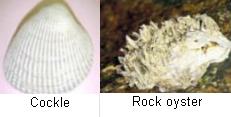
Cockles and Oysters are among a common name for certain marine bivalve mollusc, especially the common edible European species.
Cockles
Cockles are often found on beaches and in esturies just under the sand at about the low tide mark.
Cockles can grow to a length of up to 15 cm (6 in), although the largest I have ever seen would be around half this size.
Cockles have two hinged, heart-shaped shells with prominent rib markings or ribs, which aid the animal in gripping the sand. They also have a pointed muscular foot, used for moving and digging. In most adults, the foot is about as long as the greatest length of the shell.
It burrows until only the siphons project out of the sand, pulling in water from which the animal strains the minute planktonic organisms on which it feeds.
Two folds of fleshy membrane, called the mantle, cover the shells soft body and line the inside of the shell. This mantle secretes the organic and inorganic substances that make up the shell.
Most of the species known, around 200 are native to the more tropical waters.
These mollusc's feed on micro-organisms that are brought into the shell with the sea and wave movement.
Oysters
Oysters are are also found throughout the world. They usually form large beds, which extend in warm waters from the tidal zone. Oysters often attach themselves to rocks or lie on the sea bottom. They are unable to move.
The shell of the oyster is a rough irregularly oval shape, it consists of a left and right valve joined together at the narrow anterior end by a strong elastic ligament that acts as a hinge. Attached to both valves is a strong muscle called the adductor.
At the anterior end of oysters body, between two pairs of thin lips is an opening that constitutes the mouth of the oyster. It has two pairs of curved shaped respiratory organs called the gills. These are covered with hair-like structures called cilia.
A short gullet connects the mouth to the stomach and the body also contains the digestive, reproductive, circulatory, excretory, and nervous systems.
The oyster of the South Pacific are hermaphrodites (this means that their reproductive organs contain both eggs and sperm). These eggs are fertilized within the body and are retained in the gills until shell bearing larvae are formed. The larvae swim actively for about two or three weeks befor settleing on rocks or shells, where they mature by the end of the first year.
Oyster cultivation is practised in New Zealand as well as many other countries. Young oysters, called seed oysters, are placed on suitable bottoms provided with artificial collectors, such as wooden spats, tile or shells. The most elaborate system of oyster cultivation is practised in Japan, France, and the Netherlands.